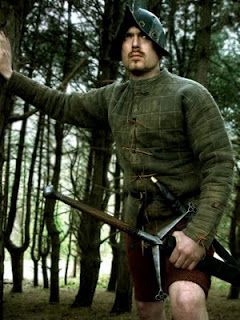THE REDSHANKS IN DONEGAL
Redshank Scottish mercenaries in Donegal
From the middle of the 16th century, a new type of Highland warrior began to appear in Ireland. These mercenaries have been called ‘New Scots’ to distinguish them from the earlier galloglaigh. In the documentation of the time, they are often referred to as Redshanks.
Redshank was a nickname for Scottish mercenaries from the Highlands’ Western Isles, a prominent feature of Irish armies throughout the 16th century. They were called Redshanks because they went dressed in kilts and waded bare-legged through rivers in the coldest weather. They armed themselves with bows and two-handed claymores.
Redshank clans: MacLeod, MacQuarrie, MacLean, MacDonald, and Campbell
They came from the clans of the Hebrides, as well as from the poorer class of mainland Scotland. The Redshanks mostly came from the clans of MacLeod, MacQuarrie, MacLean, MacDonald, and Campbell.
Unlike the Gallowglass, which were hired for long periods of service and paid in land and beef, the Redshanks were hired for the summer months. Housed with civilians, usually by force, by a system known as the Buannacht system.
The influx of Redshanks to northwest Ulster increased substantially following the marriages in 1569 of mother and daughter, Lady Agnes Campbell and Fionnuala (lníon Dubh) MacDonald, to Turlough Luineach 0’Neill and Hugh O’Donnell, respectively the lords of Tyrone and Tyrconnell.
Redshanks in Carrigans
On her marriage to O’Donnell, lníon Dubh was presented with the forts at Carrigans and Mongavlin, adjoining the River Foyle. She made Mongavlin her home. The Irish annals record that Mongavlin was a crannog – an artificial island. No trace of it survives, but water from the Foyle must have surrounded it.
It is likely that a Redshank settlement emerged in the environs of Mongavlin. Many of these warriors made Ulster their home, settling here permanently. The most prominent of the families that arrived in Donegal in the late 1500s were the Crawfords. Historians believe that 80 of the 100 men in lníon Dubh’s personal bodyguard were Crawfords.
Burt Castle
Regarding physical evidence for the connections between Scotland and East Donegal in this period, the best example is Burt Castle. It was Built by the O’Dohertys, lords of lnishowen, probably in the late 1500s. Rising from a knoll close to the shores of Lough Swilly, the ruins of this castle are visible for miles around. It was constructed on the Scottish Z-plan with round towers projecting from diagonally opposite corners.



